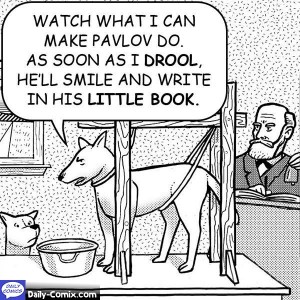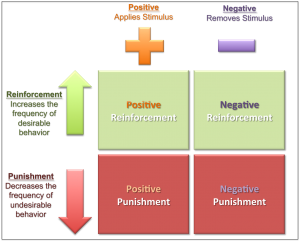There are many schools of thought when it comes to dog training. A Google or YouTube search will yield many different methods to teaching any desired behaviour . Want to teach a dog to sit – there’s a few ways to do that. Look up teaching heeling and one will be overwhelmed at the resources available. Each trainer has their own secret sauce to achieve the success they have with their dogs in any sport. Is any particular one right or wrong? Certainly not. Dogs are individuals and require tailored teaching methods in order to learn; the same thinking applies to owners as well. Dog sports are wonderful in that anyone of any ability is welcome to partake including those of any age, shape, size, able bodied or not. So what may work for one person may not work for another.
First, let’s cover the basics of learning theory.
Classical Conditioning
This is what most know as that “dog drooling experiment” conducted by Pavlov. Here a familiar stimulus that  elicits a desired response is simultaneously presented with an unfamiliar stimulus to condition the new stimulus to that same response (Fenzi & Jones, 2013). Many dog trainers use this method to develop a positive conditioned emotional response during working situations (Fenzi & Jones, 2013).
elicits a desired response is simultaneously presented with an unfamiliar stimulus to condition the new stimulus to that same response (Fenzi & Jones, 2013). Many dog trainers use this method to develop a positive conditioned emotional response during working situations (Fenzi & Jones, 2013).
Operant Conditioning
Developed by B.F. Skinner, the operant model is most commonly referred to during dog training discussions. The operant model can be easily visualized in a four quadrant chart.
 Positive – Refers to something being added after the response
Positive – Refers to something being added after the response
Negative – Refers to something being removed after the response
Reinforcement – Refers to something that increases the frequency of a behaviour
Punishment – Refers to something that decreases the frequency of behaviour
How is this a welfare issue?
Certain methodologies of training are now viewed by the public as “mean”, inhumane, and are hypothesized to elicit stress, fear and aggression. These methods are also questioned at how efficient or reliable they are for developing behaviour.
“Types” of dog trainers in dog sports are often divided into two categories: Traditional and Reinforcement Based.
Traditional dog training
A method can be considered traditional training if there is any application and/or removal of physical discomfort in the technique (Fenzi & Jones, 2013). This area of training often utilizes positive punishment and negative reinforcement to obtain the desired behaviours for the particular sport. An example of this is would be teaching the dog to heel through leash corrections. If the dog moved out of heel position (incorrect response), a jerk of the leash would be given (positive punishment because of adding something to decrease the frequency of the undesired response – in this case leaving heel.) An example of negative reinforcement would be applying leash pressure while trying to get a dog onto the dog walk (negative reinforcement because the undesired pressure will be taken away once the dog makes forward movement on the dog walk). An aversive stimulus is applied and removed once the desired response is performed. Other examples of this include the use of aversives during training; this includes shock collars, vibrating collars, prong collars and anti-bark collars.
Training using these methods may actually harm the handler-dog relationship. In a study comparing stress related behaviours between positive reinforcement and negative reinforcement based training methods, the dogs trained using negative reinforcement technique, including leash tension and pressure applied to the body, exhibited an increased frequency of yawning, lip licking and lower body posture (Deldalle & Gaunet, 2014). These are behaviours known to be associated with stress (Beerda et. al., 1998). The use of positive punishments, such as electrical shock collars,have also shown an association with elevated salivary cortisol levels particularly if there was not a warning cue that a shock was coming, and an increased frequency of tense body postures and lip licking (Cooper et. al., 2014). Cooper and colleagues (2014) also found that overall owner satisfaction with the training they received was the same between the groups using positive punishment and positive reinforcement methods, suggesting there is no real advantage between the two.
The welfare implications and efficacy of traditional methods has drawn a great amount of publicity in the last few years. Researchers continue to modify methodologies to minimize biases that may influence these results but there has been enough correlating evidence to suggest that while traditional methods may obtain the desired behaviours, the effects on stress and well being on the animal are significant enough to seek other alternatives (Cooper et. al., 2014).
The Canadian Veterinary Medical Association (CVMA) supports the use of humane training methods for dogs that are based on current scientific knowledge of learning theory. Reward-based methods are highly recommended. Aversive methods are strongly discouraged as they may cause fear, distress, anxiety, pain or physical injury to the dog.
– CVMA
October, 2015
Reinforcement Based Methods
Trainers using reinforcement based methods may also refer to themselves as science based trainers or positive trainers. Regardless of the terminology used always ask the trainer directly as each may vary slightly in their methods.
Many modern trainers are embracing the power of reinforcement to promote the dogs desire to learn and perform a behaviour while recognizing and minimizing stress during training and trialling. Proponents of these methods often promote shaping as a way of teaching behaviour. In this method the end behaviour is broken up into mini steps, allowing the dog to offer a variety of attempts with desired criteria being reinforced. As the dogs confidence grows, the trainer will begin to increase the criteria of what will earn reinforcement. Many trainers will use a clicker to mark the response that is correct.
So you want to get started in training for an event? How can one possibly sort through all of the resources available?
Take your time and ask questions! Class instructors and clubs will often openly discuss their methodology to make sure that the class is a good fit for you and your dog. There are also many resources and training classes are offered on-line now.
Some well known reinforcement based resources and classes include:
Susan Garrett’s Complete On-line Agility Handling Classroom Handling 360